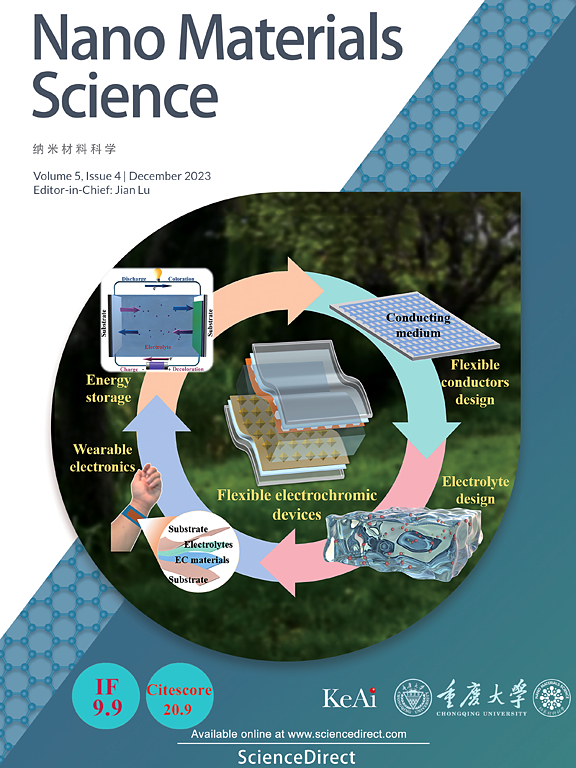作为锂离子和钾离子电池负极材料的新型联苯网络的进化预测
IF 17.9
2区 材料科学
Q1 Engineering
引用次数: 0
摘要
在先进计算算法的帮助下,更容易发现具有引人注目特性的新型材料。最近联苯网络(C)的实验合成促使我们利用进化算法和第一原理计算发现了新的掺杂 BN 的联苯网络(CBN、CBN 和 BN)及其在锂离子电池中的应用。热力学、热和机械稳定性计算以及分解能表明,可以通过实验合成所预测的联苯网络。在联苯网络中加入 BN 后,会出现从金属到半金属再到半导体的转变。BN 联苯网络的 HSE06 带隙为 3.06 eV,小于 -BN。CBN 和 CBN 联苯网络对 Li(K) 的吸附能分别为 -0.56 eV (-0.81 eV) 和 -0.14 eV (-0.28 eV),扩散势垒分别为 178 meV (58 meV) 和 251 meV (79 meV),扩散常数分别为 8.50 × 10 (8.78 × 10) 和 5.33 × 10 (4.12 × 10)。计算得出的 CBN 和 CBN 联苯网络的 Li(K) 理论容量分别为 940.21 mA h g(899.01 mA h g)和 768.08 mA h g(808.47 mA h g),低开路电压为 0.34 V (0.23 V) 和 0.17 V (0.13 V),能量密度分别高达 2576.18 mW h g (2445.31 mW h g) 和 2181.35 mW h g (2263.72 mW h g)。仅 1.6% 的微小体积变化证实了掺杂 BN 的碳基联苯网络的稳健性。我们的研究结果展示了新型二维 BN 掺杂联苯网络及其在金属离子电池中的应用途径。本文章由计算机程序翻译,如有差异,请以英文原文为准。
Evolutionary prediction of novel biphenylene networks as an anode material for lithium and potassium-ion batteries
The discovery of novel materials with compelling properties is more accessible with the help of advanced computational algorithms. Recent experimental synthesis of the biphenylene network (C6) motivated us to discover new BN-doped biphenylene networks (C4BN, C2B2N2, and B4N4) and their applications in Li(K)-ion batteries using an evolutionary algorithm and the first-principles calculations. The thermodynamic, thermal, and mechanical stability calculations and decomposition energy suggest the experimental synthesis of predicted biphenylene networks. Adding BN in the biphenylene networks shows a transition from metal to semimetal to semiconductor. The BN biphenylene network shows an HSE06 band gap of 3.06 eV, smaller than h-BN. The C4BN and C2B2N2 biphenylene networks offer Li(K) adsorption energy of −0.56 eV (−0.81 eV) and −0.14 eV (−0.28 eV), respectively, with a low diffusion barrier of 178 meV (58 meV) and 251 meV (79 meV), and a large diffusion constant of 8.50 × 10−5 (8.78 × 10−3 ) and 5.33 × 10−6 (4.12 × 10−3 ), respectively. The calculated Li(K) theoretical capacity of C4BN and C2B2N2 biphenylene networks is 940.21 mA h g−1 (899.01 mA h g−1) and 768.08 mA h g−1 (808.47 mA h g−1), with a low open circuit voltage of 0.34 V (0.23 V), and 0.17 V (0.13 V), resulting in very high energy density of 2576.18 mW h g−1 (2445.31 mW h g−1) and 2181.35 mW h g−1 (2263.72 mW h g−1), respectively. Only a slight volume change of 1.6% confirms the robustness of BN-doped carbon-based biphenylene networks. Our findings present novel 2D BN-doped biphenylene networks and a pathway toward their applications in metal-ion batteries.
求助全文
通过发布文献求助,成功后即可免费获取论文全文。
去求助
来源期刊

Nano Materials Science
Engineering-Mechanics of Materials
CiteScore
20.90
自引率
3.00%
发文量
294
审稿时长
9 weeks
期刊介绍:
Nano Materials Science (NMS) is an international and interdisciplinary, open access, scholarly journal. NMS publishes peer-reviewed original articles and reviews on nanoscale material science and nanometer devices, with topics encompassing preparation and processing; high-throughput characterization; material performance evaluation and application of material characteristics such as the microstructure and properties of one-dimensional, two-dimensional, and three-dimensional nanostructured and nanofunctional materials; design, preparation, and processing techniques; and performance evaluation technology and nanometer device applications.
 求助内容:
求助内容: 应助结果提醒方式:
应助结果提醒方式:


